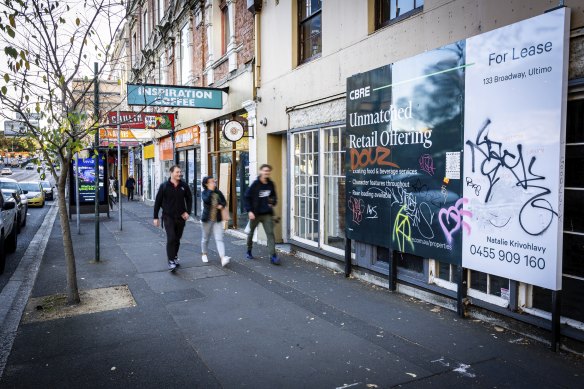‘Waterfall effect’: Recession looms as more businesses face collapse
Save articles for later
Add articles to your saved list and come back to them any time.
Australia is expected to tip into a recession in the next 12 months, driving up the rate of insolvencies in businesses as they struggle to cope with seemingly ever-increasing costs.
Up to 70 per cent of insolvency practitioners, lawyers, managers and corporate debt restructuring specialists believe there will be a recession over the 12 months. As many as 90 per cent of the insolvency sector experts surveyed believe the economy will tip into a recession in the next two years.
Higher rent and power cost and other inflationary concerns could send more businesses to the wall in the next 12 months.Credit: Ben Symons
The figures come from the annual survey conducted by KordaMentha and Turnaround Management Association (TMA) of 115 professionals linked to the restructuring sector. The survey also found that sentiment about the economy was now worse than it had been for the five years it has been running. The TMA covers the advisory groups that usually work on larger corporate collapses and the law firms and debt market professionals that assist them.
Increased interest rates and ongoing concerns about costs – such as building materials, rents, transport and power costs – are driving the dour outlook for the economy, according to the survey.
Another concern is the increased enforcement activity of the Australian Taxation Office, which provided a two-year grace period to businesses that had failed to pay their taxes during the COVID pandemic.
Corporate insolvencies jumped 62 per cent in the year to June to the highest level since 2018-2019. According to figures released by the corporate watchdog, 7943 companies appointed administrators, liquidators or receivers in 2022-2023.
There are also growing signs that company directors, particularly small business leaders, are going broke. A separate report from the Australian Financial Security Authority found that personal bankruptcies had dramatically increased in May, jumping to 1031 from 769 the month prior.
“The ATO have been proactively reducing their arrears for some time now, and we expect this trend to continue and the ATO to be more proactive in the market,” said Sebastian Hams, a restructuring partner at KordaMentha.
Part of the change in outlook has been caused by increased interest rates, the survey found, but there is also the overhang of COVID where many businesses received support from the government and the ATO amnesty. As a result, turnaround specialists surveyed believe many businesses are not prepared for such a severe economic downturn.
‘Construction was the first industry to be affected, unable to pass on rising costs due to fixed-price contracts. We are now seeing other industries affected […] It’s trickling through the economy.’
“During and post COVID we had supply chain issues, which affected costs for manufacturing,” said James Wagg, KordaMentha Executive Director Performance Improvement.
“Now rising interest rates and inflation with resulting cost increases are causing a drop in discretionary spending and profitability. So many borrowers have been forced to the secondary, more expensive money market,” Wagg said.
Against this backdrop, relatively healthy businesses are shrinking their business or winding back their growth aspirations. Several thousand staff have already lost their jobs in Australia’s nascent start-up scene following a series of collapses of the profit-less, growth-driven businesses including food-focused delivery services Milkrun and Providoor.
Those collapses followed a run of corporate failures in the economically battered building sector, hitting companies including Porter Davis, Mahercorp and Toplace.
Wagg said the tightening of the economic outlook was causing a waterfall effect for businesses.
“Construction was the first industry to be affected, unable to pass on rising costs due to fixed-price contracts. We are now seeing other industries affected, like retail impacted by increased cost of living and reduced consumer spending.
“The next are likely to be services industries such as health as government funding fails to keep up with increasing costs. It’s trickling through the economy.”
The Business Briefing newsletter delivers major stories, exclusive coverage and expert opinion. Sign up to get it every weekday morning.
Most Viewed in Business
From our partners
Source: Read Full Article


